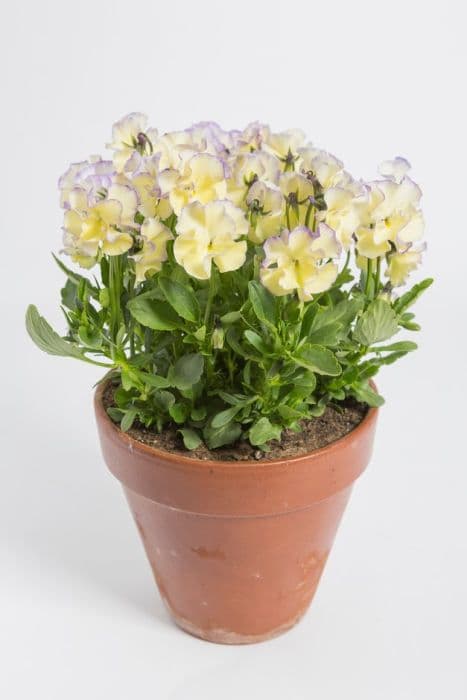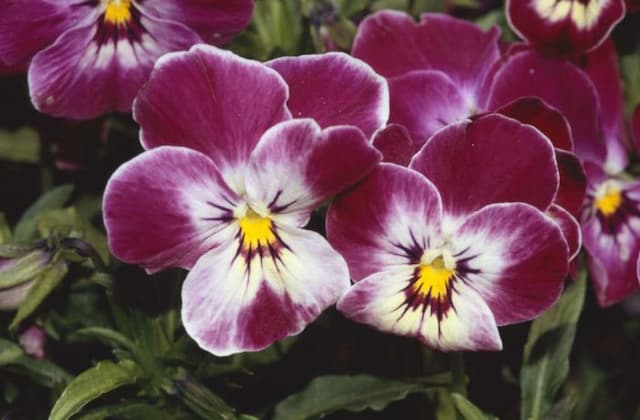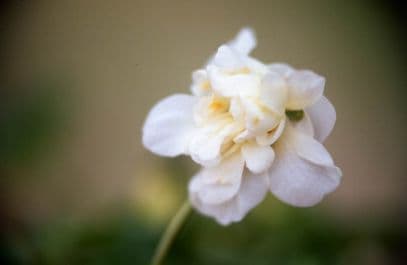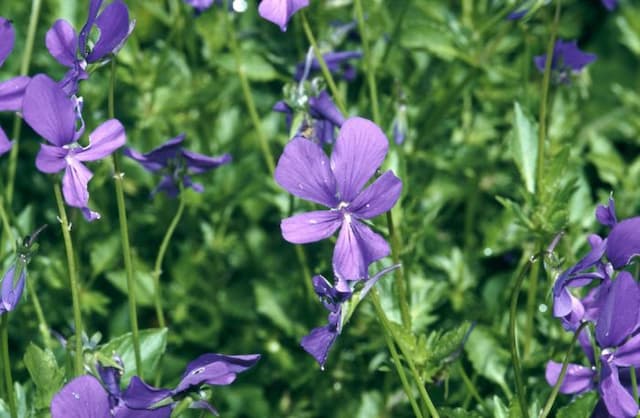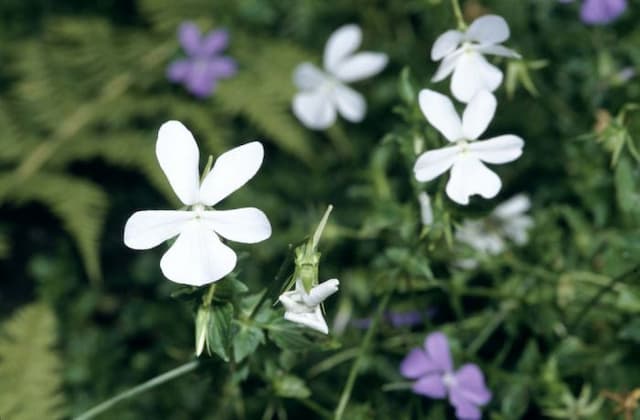Pansy Viola Sorbet Series (Va)

ABOUT
The Viola Sorbet Series, popularly known as pansies, are renowned for their charming and colorful flowers that brighten up gardens and landscapes. These delightful plants bear broad, rounded petals that overlap slightly, creating a characteristic face-like pattern that many people adore. The blossoms come in an array of colors, including shades of blue, purple, red, yellow, white, and even bicolored or multicolored varieties, which may sport intricate markings and whiskers. The flowers are typically accompanied by compact green foliage, consisting of oval to heart-shaped leaves that provide a lush backdrop for the vibrant blooms. Pansies in the Sorbet Series can flourish in cool weather, which allows them to maintain their beauty in both spring and fall, when many other plants might not be as vigorous.
About this plant
 Names
NamesSynonyms
Johnny Jump Up, Horned Violet, Heartsease, Penny Jump Up, Viola, Jolly Jumps, Field Pansy, Wild Pansy
Common names
Viola Sorbet Series (Va).
 Toxicity
ToxicityTo humans
The common name for Viola Sorbet Series (Va) is Viola or Pansy. Pansies are generally considered non-toxic to humans. However, as with any plant, some individuals may have sensitivities or allergies that could cause discomfort or an allergic reaction. Typical consumption of pansies (such as using them as an edible garnish) is not known to cause poisoning or serious health consequences for humans.
To pets
Violas or Pansies are not known to be toxic to pets such as cats and dogs. If a pet were to ingest a large amount of pansies, they might experience mild gastrointestinal discomfort, but serious toxicity or long-term health effects are unlikely. Always monitor your pets around plants and consult with your veterinarian if you observe any signs of distress after ingestion.
 Characteristics
CharacteristicsLife cycle
Perennials
Foliage type
Evergreen
Color of leaves
Green
Flower color
Varies
Height
6-8 inches (15-20 cm)
Spread
6-8 inches (15-20 cm)
Plant type
Herb
Hardiness zones
5-9
Native area
Europe
Benefits
 General Benefits
General Benefits- Enhanced Garden Aesthetics - The Viola Sorbet Series, commonly known as Violas or Pansies, adds vibrant colors and visual interest to gardens and landscapes.
- Extended Blooming Season - Violas have a long flowering period, spanning from early spring to the first frost, ensuring a colorful display for extended periods.
- Drought Tolerance - Once established, Violas are quite resilient and can tolerate short periods of drought, reducing the need for frequent watering.
- Cold Resistance - They are hardy plants that can survive and bloom in cooler temperatures, making them a great addition for fall and winter gardens.
- Easy to Grow - Violas are low maintenance and can thrive with basic care, making them suitable for novice gardeners or those who prefer less demanding plants.
- Attracts Pollinators - The flowers attract butterflies and bees, which help pollinate other plants in the garden, supporting biodiversity.
- Versatility in Use - Violas are suitable for a variety of garden settings including borders, containers, and hanging baskets, offering flexibility in garden design.
- Edible Flowers - The blooms are edible and can be used to decorate salads, desserts, and drinks, adding a touch of elegance to culinary dishes.
- Ground Cover - Violas can be used as a ground cover to fill in empty spaces, suppress weeds, and maintain soil moisture.
- Seasonal Flexibility - They can be planted as annuals or perennials depending on the climate, giving gardeners the ability to plan their garden seasonally.
 Medical Properties
Medical PropertiesThis plant is not used for medical purposes.
 Air-purifying Qualities
Air-purifying QualitiesThis plant is not specifically known for air purifying qualities.
 Other Uses
Other Uses- Plant-Dyed Fabrics: The flowers of Viola can be used to naturally dye fabrics, imparting a soft lavender to blue hue depending on the mordant used.
- Edible Decor: Viola flowers can adorn cakes or desserts, adding a touch of elegance and a mild sweet flavor.
- Viola Ice Cubes: Freeze the blooms inside ice cubes for an eye-catching addition to beverages during spring and summer gatherings.
- Flavoring Agent: The flowers can be infused into syrups or vinegars to create unique flavors in culinary applications.
- Garden Markers: Pressed Viola flowers can be laminated and used as plant markers in the garden for a natural and decorative touch.
- Viola Potpourri: Dried Viola flowers can be added to potpourri mixes for a subtle fragrance in the home.
- Photography Subjects: Violas, with their diverse colors, can provide a vibrant and attractive backdrop for macro photography.
- Candle Embeds: The small flowers of Violas can be embedded into candles for an aesthetic appeal as the candle burns down.
- Nature Crafts: Use Viola flowers for crafting, such as making bookmarks, greeting cards, or framed botanical art.
- Companion Planting: Violas can be planted alongside vegetables like lettuce and radishes to attract pollinators and beneficial insects to the garden.
Interesting Facts
 Feng Shui
Feng ShuiThe Pansy, being symbolically connected to thoughts and consideration, in Feng Shui could be used in areas of the home where introspection, intellectual conversations, and thoughtful communication are desired, like a study room or living area, to enhance the energy of contemplation and understanding.
 Zodiac Sign Compitability
Zodiac Sign CompitabilityThe Pansy is not used in astrology practice.
 Plant Symbolism
Plant Symbolism- Thoughtfulness and Remembrance: Violas, often referred to as pansies, are commonly associated with the idea of remembrance and the act of thinking deeply about someone, stemming from their presence in literature and folklore as symbols of thoughtfulness.
- Innocence: The delicate and unassuming nature of the viola often represents innocence, making it a symbol of youth and purity.
- Loving Thoughts: Giving someone a viola can signify the sender's loving thoughts towards the recipient, embodying a quiet and enduring love.
- Humble Beauty: Despite their small size, violas are known for their beautiful and varied colors, symbolizing the understated elegance of humble beauty.
 Water
WaterPansies, which the Viola Sorbet Series fall under, should be watered regularly to keep the soil consistently moist but not waterlogged. During active growth in the spring and fall, they may need water about once a week, but this can vary depending on the climate and soil conditions. In general, apply approximately one inch of water, which is about 0.623 gallons for a square foot, each week, adjusting for rainfall. Water pansies early in the morning at the base of the plant to allow foliage time to dry and to reduce the risk of disease.
 Light
LightPansies thrive in a spot that receives full to partial sunlight. They perform best with at least six hours of direct sunlight per day. However, in areas with very hot summers, providing some afternoon shade can help protect the plants and prolong flowering. The ideal location for pansies would be one where they can enjoy morning sunlight and be sheltered from the intense sun in the afternoon.
 Temperature
TemperaturePansies prefer cool weather and can tolerate a wide temperature range, making them ideal for fall and spring planting. They can survive temperatures down to about 20°F but perform best when temperatures are between 40°F and 60°F. In regions with mild winters, pansies can bloom throughout the winter months. However, prolonged temperatures above 80°F can cause pansies to become leggy and reduce flowering.
 Pruning
PruningRegular deadheading, which is the removal of spent flowers, encourages pansies to produce more blooms and prevents them from going to seed. Deadhead pansies weekly or as needed when you notice faded or dead blossoms. Pruning can be done any time during the blooming season to maintain a tidy appearance and to help stimulate new growth. The best time to prune pansies for shaping or to remove damaged leaves is in early spring or fall.
 Cleaning
CleaningAs needed
 Soil
SoilJohnny Jump Ups thrive in moist, well-draining soil with a pH between 6.0 and 6.5, ideally composed of loam or a mix of peat, compost, and perlite or vermiculite.
 Repotting
RepottingJohnny Jump Ups typically don't require frequent repotting; do it every 1-2 years or when they outgrow their current container.
 Humidity & Misting
Humidity & MistingJohnny Jump Ups do well in average outdoor humidity levels; they generally do not require specific humidity adjustments.
 Suitable locations
Suitable locationsIndoor
Keep Johnny Jump Ups in bright, indirect light and cool temperatures indoors.
Outdoor
Plant Johnny Jump Ups in partial shade to full sun in cooler climates.
Hardiness zone
4-9 USDA
 Life cycle
Life cycleThe Viola Sorbet Series, commonly referred to as pansies, begin their life cycle as seeds which, upon sowing and experiencing suitable conditions of moisture and temperature, germinate and push out roots and shoots. Seedlings emerge and grow into juvenile plants, developing true leaves that are characteristic of pansies, such as their round to oval shape with slightly serrated edges. As the plants mature, they enter a vegetative stage marked by the development of a sturdy stem and a rosette of leaves, preparing the plant for flowering. The flowering stage occurs when the pansies produce their distinctive colorful blooms with two slightly overlapping upper petals, two side petals, and a single bottom petal with a slight beard emanating from the center. After pollination, often by insects, the flowers develop into seed capsules, which eventually dry and release new seeds, thus completing their reproductive cycle. During the winter or unfavorable conditions, pansies may enter a period of dormancy, slowing their growth, but with the return of favorable conditions, they resume their growth, potentially leading to another flowering cycle if they are perennials or biennials in their specific environment.
 Propogation
PropogationPropogation time
Spring-Summer
The Viola Sorbet Series, commonly known as the pansy, can be effectively propagated by seed. The most popular method is to sow the tiny seeds indoors about 8 to 12 weeks before the last spring frost date. Seeds should be placed on top of moist, well-drained seed starting mix and lightly pressed into the surface, as light is needed for germination. Covering the seed tray with plastic wrap can help to maintain humidity. It's important to keep the soil temperature around 65 to 70 degrees Fahrenheit (18 to 21 degrees Celsius) for optimal germination, which usually occurs within 10 to 14 days. After seedlings have grown sufficiently and the danger of frost has passed, they can be transplanted outdoors to their final growing positions, spaced approximately 6 to 8 inches (15 to 20 centimeters) apart to ensure adequate room for growth.
